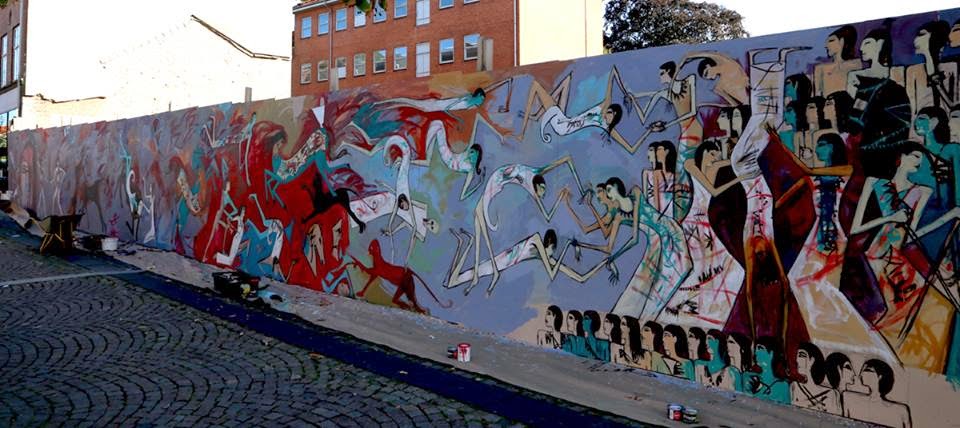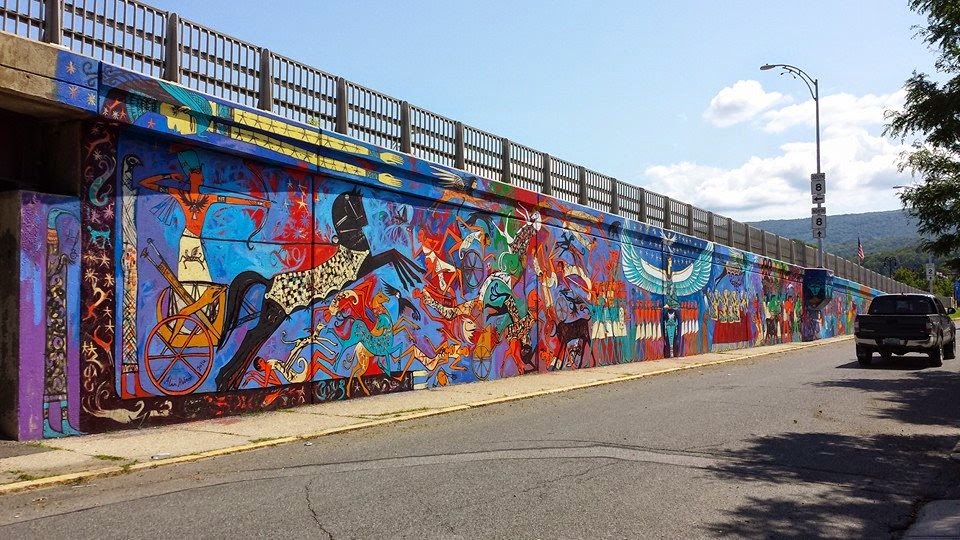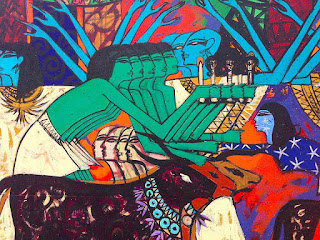"We can't know our future if we forget our Past."
Alaa Awad
Alaa Awad - The Power of Mural Art
(An exercise of urban interference wielded
towards an Art so great and sovereign as Egypt itself!)
The artist's palette
Graffiti transformed along with the years as one of the greatest urban art manifestations to happen in cosmopolitan environments. It gained space in walls of big cities in striking, dynamic and amazing way, praising at the same time a visual conquest that aims pure comunication with masses, screaming loudly on panoramic images messages that words cannot express so colorfully. One of the meanings of graffiti's language is the wishing pictorial expression of people's thoughts as much as its social denouncings for a most wide and popular range.
"How far away is the horizon?" - Denmark - 2013
Mural of Justice - Massachusetts, USA - 2014
It is a kind of art aimed for the moment. It doesn't restrict itself just for the rooms of museums or art galleries. The always arising question about the surviving of these works, exposed to weather conditions such as sun, rain and polution, makes its turning point on the idea that ephemeral can be sublimed to enjoyment as aesthetic cathegory while still present and alive. But it's a momentaneous work that endures itself until the eternal, while it stays and endures, luckly visible for those gifted enough to see it! Like divine visions, epiphanies creating inner understandings that last forever!
Maybe we can consider graffitis as potential and virtual extension of muralist art, whose last explosion in the Mexican Muralist Movement in the thirties got a new proeminence as a political and social tool with such strong appeal and language until then never reached.
Diego Rivera, Jose Orozco and David Siqueros were the main exponents of it. Born from a crescent social conscientization between Mexican intelectuals, the muralist art found on those artists a catalyst nest for the expressed necessities of a social reformulation that was occurring since November 1910 with the beggining of the Mexican Revolution.
Diego Rivera - Man at the Crossroads
It is considered that this process lasted until the end of the forties, what places Rivera, Siqueros and Orozco just in the heart of the hurricane. It is important to highlight how much the language of murals is by some reason intrinsically connected with maximum expressions of nation's needs.
Once upon a time, in Tahrir Square...
Awad's mural of a pharaoh smiting enemies on Mohammed Mahmoud Street 2012, a reminder of the 'martyrs' killed during the revolution.
Awad's mural of a pharaoh smiting enemies on Mohammed Mahmoud Street 2012, a reminder of the 'martyrs' killed during the revolution.
The women climbing the ladder - 2012 - Cairo
Free from gravitational laws they are climbing for Freedom.
A sacred symbol of the goddess Nut was the ladder, used by Osiris to enter her heavenly skies.
Alaa Awad said about this graffiti: "Here you see women as the ancient Egyptians depicted them. They are climbing a ladder that symbolizes the revolution. They must break through where the ladder meets the sky. The women are nude; they are beautiful. They are not covering their bodies. We are Muslims but we don't believe in the Wahhabi style of Islam that has been imported to Egypt. Egypt has a long long history and its own traditions."
"The Marching Women" - Oil on Canvas, 2012
More rigid in shape, aiming their goals and bringing requests in their hands, they march in unison, as a single and unique body moving forward with harmony and independence.
There is a particular wisdom in the use of colors here. They create transparences on the bodies and the hazy enlightened green in the background seems to emerge from pure light and projects its nuances on the group, this one balanced by determination and reason, respectively red and deep cobalt blue.
Apis: Life and Death, Acrylic on Paper, 2012
Freedom I, Oil on Paper, 2011
Human figures floating in the air like in a cosmic dance: Bodies forming letters on air as if creating by themselves their own destiny...
Freedom II Acrylic on Paper, 2011
Freedom II - Acrylic on Paper, 2011
The murals started being part of people's life...
"By the summer of 2011 people started to talk about the walls of Egypt being under an 'art attack'."
Mia Gröndahl in her book 'Revolution Graffiti: Street Art of the New Egypt'.
“People
in Egypt love street art. There is an old heritage of expressing
yourself in images here, so they are no strangers to it. It has
become an integrated part of the continuous struggle for freedom. The
graffiti reminds people that the revolution isn't over yet.”
Mia
Gröndahl
Cairo 2012 - Mahmoud Street
Sometimes his paintings have the same struggle showed in Picasso's 'Guernica'...
Even exercing his many activities as an artist much before, Alaa Awad gained larger projection after the manifestations of Tahir Square in 2012, Cairo, an event that followed the insane massacre in Port Said Stadium on February 1 of that year. His graffites started then to reflect the attitudes of protest against the Suprem Court of Army Forces (SCAF).
The ceaseless murals that Alaa painted in Mohammed Mahmoud Street at that time, together with some other artists, became the witness of a battle field between visual arts and government power. The paintings were constantly erased (see bellow) by army forces but steadly repainted by the inspiring power of Egyptian Artists' protests.
Part of Alaa's Mural can be seen on the left corner of the celebrated wall in Mohammed Mahmoud Street.
(And bellow the whole iconic work)
Mural Painting on the walls of American University of Cairo, 2012
The mourners put earth on their heads. The coffin is a mosaic, as much as the door. Over both the Ba Bird makes the link between the two worlds, received with candles by beautiful flying deities. The goddess Nut frames the scene on top, protecting all worlds. On bottom right, black flowers, instead of blue lotus are offered as a dark symbol for mourning.
(Detail of the mourners)
Ramose's Tomb, considered one of the masterpieces of the 18th Art Dinasty: pure inspiration for Alaa's work, whose art, in fantastic colors renew the pictorial tradition of Ancient Egypt.
A woman feeds and protects her child from the attack of wild beasts. Mother Egypt holding her sons... Cairo - 2012
Sheikh Rehan Street with Mohammed Mahmoud Street, Cairo 2012
Detail from painting above
Cairo, 2012
Even the barricades builded to block the roads that give access to Tahir Square were painted by them in such a way that could recreate in a way the perspectives of those roads, as if the pictorial space would open for once at all the paths for a common sense, increasing a unison voice against a bad and terrible government full of corruptions and injustices. That's the wonderful power of true art!
The blocking roads that give access to Tahrir Square painted by Egyptian artists, friends with Alaa Awad.
Alaa in front one of the blocking walls: Colors opening new perpectives through the rocks...
Art overcoming limits!
How Far Away is the Horizon? Open-Air Group Exhibition - Denmark, 2013
Denmark, 2013 (Detail)
Denmark, 2013
About Alaa...
Alaa Awad graduated from South Valley University, the Luxor’s Faculty of Fine Arts in 2004 and soon developed in this same institutional entity his career as teacher in the Department of Mural Painting. In 2012, taking a break from his job soon after the events in Port Said Stadium, Alaa went to Cairo on February 3, and stayed there for almost forty five days involved in all manifestations of urban interference and protest on the murals of Mohammed Mahmoud Street.
Advocating a struggling thematic expressed in brilliant form through a style clearly and lightly inspired on the magnificient art of Ancient Egypt, his Art refutes the established power praising instead of it, excelellence and nobility of people, to whom his art is especificaly focused as a slogan for freedom. Alaa uses very simple materials for his paintings and gets out completely from the usually resourses employed by usual language of graffiti, like sprays or stencils. His instruments for divinization are cheap tints and very course brushes. The sharped and precise lines of the artist's hands remind us the precious carvings on Karnak Temple's stones and cover a so dignified space as well as the apocalyptical dimensions of Abu Simbel do.
Between November 2013 and February 2014 Alaa Awad showed this painting in the exhibition Power of Powerless in Baden-Baden, Germany. The mystic Buraq being honored by music, dance and singing. Freedom facing the conquest, quietly staring at the crowd of offerings. Behind emerges the consciousness of Freedom from whose mind comes all liberty and lucidity. A winged being raises the wings of an human headed bird (the Ba Bird, symbol of the soul) sustained from the other side by consciousness's arms of people, just on the top of Buraq's head, coincidently. When clarity for all will be supported by the Truth, then new possibilities will emerge.
Tarab in the West
In June of 2014, invited by the Masachussetts College of Liberal Arts, Alaa went to USA to paint the beautiful Mural of Justice, what he accomplished in two weeks. Together with this marvelous work in the walls of a busy road he had too a solo exhibition in Gallery 51. That's Egypt conquering the heart of America!
The Mural of Justice - United States, 2014
The Cosmology of Order in the pointing out of the warrior's arrow. Nut, carrying all stars on her divine body embraces the destiny's picture giving her blessings.
(Detail on the Mural of Justice , right side)
Harmony between all beings. Beauty, Equanimity and Movement brings an enlightened feeling, close to the experience of a musical Tarab. Everything is fantastic!
Work in Progress (Detail from painting above)
Mural of Justice (Detail)
Mural of Justice (Detail)
In this way, Alaa is reinventing the Egyptian Mithology and establishing what has being called Neo-Pharonic Style. The artist wisely says: "We can't know our future if we forget our past." The Egyptian pantheon, so rich in gods and symbols, has on the modernity of its new expression through Alaa's Art an striking revelation. The aesthetic of the art created in Ancient Egypt as a whole is extremely contemporary! Transposed to our days it is staggering how much make sense the multiplied profiles of warriors or women in battlefronts strong-willed going for their specific goals situated in a pictorical space where Alaa reminds many times, and with an overpowering autenticity, the gravitacional freedom found in Marc Chagall and Henry Matisse. In his murals, the almost geometrical rigour of the characters seems like floating on the screen creating like this an intimacy that makes our eyes and senses dance together in the same embracing rhythm of his athmospheres...
The Hope - Oil on canvas - 2015
The figures are very suportive to each other. Bodies floating in the sky forming letters to write their own destinies. The structure of the scene builded from lines in different levels creates harmony and comon sense where everybody accomplish rejoycing. The eyes of evil (greedness and corruption) at the very right bottom corner watching with envy and jealousy.
"Uniting" - Urban Art Biennial, Germany - 2015
The pointing out of the main figure is like the aimed target of a weapon. Again the group is builded as a great basis for a human pyramid with the women on top of it, a deserving place the artist always save for them, in the higher on the compositions, rejoycing and suporting everything. Horses invite us for power and movement.
Dynamic shapes and movements...
Walls in Mesala Hotel - West Bank, Luxor - 2015
Tefnut the lioness headed goddess of rain and moisture on the extreme left side, kindly touches the shoulders of the warrior, as a reminder of the interference of the gods in human life. Tefnut, connected with the moon is considered the left eye of Atum Ra, together with her brother Shu, the right eye, connected with the sun. This trinity resembles the composition of the mural that seems to be divided too into three sections, with the protection of the goddess Isis in the center.
Work in progress - West Bank, Luxor - (Detail)
Life size...
Daughter of the goddess Nut, Isis has the power of regeneration and embrances all worlds. (Detail)
An astonishing sky surrounds here a world ruled by harmony and reverence...
The pointing out of the main figure is like the aimed target of a weapon. Again the group is builded as a great basis for a human pyramid with the women on top of it, a deserving place the artist always save for them, in the higher on the compositions, rejoycing and suporting everything. Horses invite us for power and movement.
Dynamic shapes and movements...
A
beautiful masterpiece emerged this year in the West Bank of Luxor in
the walls of Mesala Hotel. The enigmatic work shows again the same
divisions between two worlds. Chaos and Order aligned and balanced by
the protective wings of the goddess in the center.
Tefnut the lioness headed goddess of rain and moisture on the extreme left side, kindly touches the shoulders of the warrior, as a reminder of the interference of the gods in human life. Tefnut, connected with the moon is considered the left eye of Atum Ra, together with her brother Shu, the right eye, connected with the sun. This trinity resembles the composition of the mural that seems to be divided too into three sections, with the protection of the goddess Isis in the center.
Work in progress - West Bank, Luxor - (Detail)
Life size...
Daughter of the goddess Nut, Isis has the power of regeneration and embrances all worlds. (Detail)
Right side of West Bank Mural (Detail)
A closer detail shows the mastery in the use of colors enriched by the power of Alaa's sharp lines on his amazing drawings, and we can clearly realize on each face a personal character, a distinctive soul, real individuals with the same goals. The athmosphere is sovereign, full of bliss and awakened serenity: divine blessings!
A naked body knells like being purified by a priestess. Ethereal figures seems to emerge from the crowd, like in a ritual: perfect marriage of heaven and earth.
A naked body knells like being purified by a priestess. Ethereal figures seems to emerge from the crowd, like in a ritual: perfect marriage of heaven and earth.
It
is staggering to realize how the new astonishing aesthetics of Alaa
are always evolving and creating by themselves a flashing cosmos in a steady
evolution, just in front of our eyes. The fact that the artist is searching
inspiration in the sacred Art of Ancient Egypt work out as a crucial
changing, not only in the way we will start looking to Art from now on, but even as an enlightening limelight for the way we can understand the Art that
Egypt was producing in the past, thousand years ago. When asked about
this source of inspiration he heralded that time his now so renowned
statement:
“I
am proud about it, when I was young, I saw pictures of Tutankhamon,
Nefertari and Nefertiti. They were like treasures for me. Ancient
Egypt was a big civilization. I must make people remember this
culture, this history – because we can loose it! And we can't know
our future if we forget our past.”
The miracle that occurs when one observes an essencial work of art, such as Alaa Awad's paintings, dwells in the fact that they can create a huge and magical pictorial reality enwraping the observer in such a way that the sensation of sharing the same imaginative space erases differences and distances between the observed object of art and those who observe it! No dimensional differences! Pure Tarab!
In a certain way, Art redeems men of their usual and ordinary context, elevating them to a condition that exists in another dimension of reality, this turn prioritarily sensorial and perceptive. It creates wings! In this sense, the paintings of Alaa Awad, as much as his murals are ascending redemptions for our condition of mere bipedal beings moving into three dimensions. Like the colossal gothic cathedrals, the experience with an art created in big scales has the talent of wisely unifying macro and micro.
According to this, we can think and conceive Alaa Awad's Art as an autentic and alive experience on the rare idea of regeneration.
The Buraq's velocity running in three legs in most pure green, the color of Islam. Another symbol for freedom, having inside all stories and knowledge, pure wisdom! The Mystic Bird too is looking to the past to understand the future...
How Far Away is the Horizon?
Always something is coming out from his palette, the Ba Bird blowing from the instrument like pushing the procession of women in front carrying ankhs on their hands as a symbol for supreme life!
Mourners
Mourners (Detail)
Green Nut - Oil on Canvas, 2015
Green Nut (Details)
Mourners
Mourners (Detail)
Green Nut - Oil on Canvas, 2015
Green Nut (Details)
Women with Birds - Oil on Canvas, 2014
Women with Birds (Detail)
Mural of Justice - Massachusetts, USA - 2014
From Mother Egypt to the world...
Grondahl, Mia: "Revolution Graffiti: Street Art and the New Egypt", 2013 ISBN:9789774165764
Ali, Claudia: Author Talk: Ancient Egypt Meets Street Art - The Artist Alaa Awad from Luxor, 2013 <http://www.leben-in-luxor.de/luxor_essays_street_art.html>
























































































http://www.cairoscene.com/ArtsAndCulture/Explaining-Alaa-Awad-The-Man-Behind-The-Paintbrush
ResponderExcluir